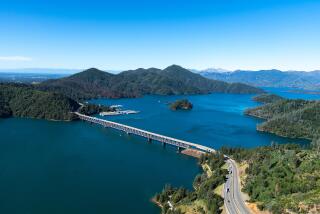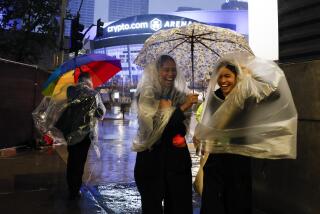Is Californiaâs drought ending? Itâs too soon to say
Itâs too early to know if Californiaâs three-year drought is ending, but the train of storms that plowed into California last week pushed the critical mountain snowpack to slightly above normal levels and sent water rushing into half-empty reservoirs.
At his office at Shasta Dam north of Redding, Brian Person watched the biggest reservoir in the state rise 4 to 5 feet a day on Wednesday and Thursday.
âParticularly following the abysmal hydrology of â07, â08 and â09, this is a fantastic experience,â said Person, an area manager with the U.S. Bureau of Reclamation.
In the Sierra Nevada, the storms that rode in on howling jet-stream winds dumped 4 to 6 feet of snow and boosted the water content of the snowpack by 20%.
âThatâs no shabby thing,â said Maury Roos, the stateâs chief hydrologist.
Forecasters at the National Weather Serviceâs Climate Prediction Center say a strong El Niño has developed in the Pacific Ocean and will continue into the spring, raising hopes for more of the same.
âThere are no guarantees,â said center deputy director Mike Halpert. âBut things should be favorable . . . during the next couple of months for more storms moving through the jet stream and impacting California.
âThese are the types of winters that are most beneficial to the water supply.â
El Niño is a warming of sea surface temperatures in the equatorial Pacific that influences weather patterns, often sending storms to California.
But Bill Patzert, a climatologist at NASAâs Jet Propulsion Laboratory -- who has disagreed with federal forecasters in the past -- believes the current El Niño is a modest one and predicts another year of below average precipitation.
Patzert argues that the macho El Niños that drench the state and push rainfall amounts to record levels donât occur often.
âThe impact of El Niño I think is exaggerated,â he said.
The drought is not the worst the state has experienced in the modern era, but as a three-year period, it ranks in the driest 10%, Roos said.
The precipitation shortfalls have been bad enough to prompt water restrictions for urban customers around the state and to cut irrigation deliveries to agriculture, forcing some farmers to pump groundwater and leave fields unplanted.
In the last century, Roos said, California experienced two droughts that lasted six years: 1929 through 1934 and 1987 through 1992.
A drought in the late 1940s lasted four years.
But more often, he added, âIn three years itâs done -- and the year that ends it turns out to be a wet one.
âWe canât say that this is going to be wet yet. But Iâm optimistic that it will at least be above average.â
As of Friday, the snowpack in the Northern Sierra was 117% of average for this time of year. Statewide it was 107% of the norm. The snowpack season runs from December through March.
Shasta Damâs reservoir, fed by the northern end of the Sacramento River and its tributaries, rose 24 feet in 10 days.
But until the stateâs major reservoirs return to normal levels, the drought is not over.
âWeâve got quite a hole in statewide storage,â Roos said.
Frank Gehrke, chief of the California Cooperative Snow Surveys program, is keeping his fingers crossed for the rest of the winter. Forecasts, he said, are just that.
âUntil itâs on the ground, Iâve seen too many situations where things just donât pan out.â
More to Read
Sign up for Essential California
The most important California stories and recommendations in your inbox every morning.
You may occasionally receive promotional content from the Los Angeles Times.











